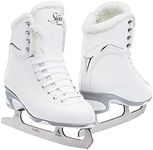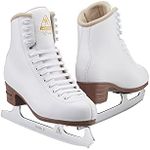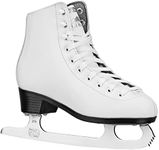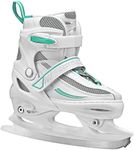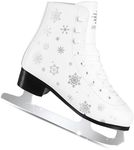Buying Guide for the Best Recreational Ice Skates
Choosing the right pair of recreational ice skates can greatly enhance your skating experience, whether you're a beginner or an experienced skater. The key is to find skates that offer the right balance of comfort, support, and performance for your specific needs. Here are some important specifications to consider when selecting recreational ice skates, along with explanations to help you make an informed decision.Fit and ComfortFit and comfort are crucial because they directly affect your skating experience. Skates that are too tight can cause pain and blisters, while skates that are too loose can lead to instability and poor control. When trying on skates, make sure they fit snugly but comfortably, with no pinching or excessive movement. Consider the width of your feet and look for skates that offer a good fit for your foot shape. If you plan to skate for extended periods, prioritize comfort to avoid discomfort and fatigue.
Support and Ankle StabilitySupport and ankle stability are important for maintaining balance and control on the ice. Skates with good ankle support help prevent injuries and improve your ability to perform maneuvers. Look for skates with a firm, supportive boot that provides adequate ankle support. Beginners may benefit from skates with more support, while experienced skaters might prefer a bit more flexibility for advanced movements. Assess your skill level and choose skates that offer the right amount of support for your needs.
Blade QualityThe quality of the blade affects your glide and control on the ice. High-quality blades are made from durable materials and maintain their edge longer, providing a smoother and more responsive skating experience. Blades come in different profiles and sizes, with some designed for specific types of skating. For recreational skating, look for blades that are pre-sharpened and made from stainless steel or carbon steel. If you plan to skate frequently, consider investing in skates with higher-quality blades for better performance and longevity.
Boot MaterialThe material of the boot influences the skate's durability, weight, and comfort. Common materials include leather, synthetic leather, and composite materials. Leather boots are durable and offer a traditional feel, but they can be heavier and require more maintenance. Synthetic materials are lighter and often more affordable, but they may not offer the same level of durability. Composite materials provide a good balance of weight, durability, and comfort. Consider your preferences and how often you plan to skate when choosing the boot material.
Lacing SystemThe lacing system affects how securely the skates fit and how easy they are to put on and take off. Traditional laces offer a customizable fit and are preferred by many skaters for their ability to adjust tightness in specific areas. Some skates feature quick-lace systems or combination lacing with buckles and straps for added convenience and support. Think about how much time you want to spend lacing up and how important a precise fit is to you when selecting the lacing system.
Padding and InsulationPadding and insulation contribute to the overall comfort and warmth of the skates. Well-padded skates provide cushioning to reduce pressure points and enhance comfort during long skating sessions. Insulated skates help keep your feet warm, which is especially important if you plan to skate outdoors in cold weather. Look for skates with ample padding around the ankles and tongue, and consider insulated options if you often skate in colder environments.

